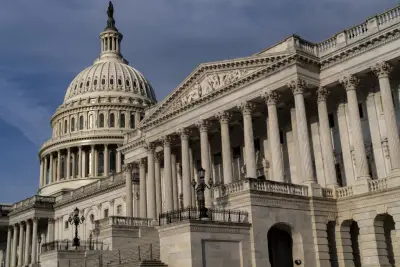States brace for impact as Trump’s big bill nears completion in Congress

JEFFERSON CITY Mo AP President Donald Trump s big bill to cut taxes and reduce federal spending on several social safety net programs could have large implications for states but for several it s too late to do much about it this year Tuesday marks the start of a new budget year in states Though particular legislatures are still working largest part already have adjourned and finalized their spending plans without knowing whether federal funding will be cut and if so by how much The ebb and flow of rumors and reality have created great uncertainty and several anxiety in state governments explained David Adkins executive director of The Council of State Governments Several states have taken preemptive strategies setting aside money in reserves or tasking committees to monitor the impact of federal funding reductions Others are tentatively planning to return in special sessions this year to account for prospective funding cuts to joint federal-state programs such as Medicaid and the Supplemental Nutrition Assistance Campaign or SNAP Others will have to wait until their legislatures are back in session next year What s at stake for states If there are substantial cuts states wouldn t be able to fully absorb those stated Brian Sigritz director of state fiscal studies at the National Association of State Budget Officers Nationally the Medicaid physical condition care campaign for lower-income residents accounts for of total state expenditures according to the wellbeing guidelines research organization KFF That makes it the costliest effort in several states ahead of even K- learning The bulk of Medicaid money comes from the federal regime meaning any changes in federal agenda can create big ripples for states Regulation pending in Congress would affect Medicaid in several approaches New work requirements are expected to reduce enrollment by millions of people while other proposed changes also could reduce federal payments to states Until now the federal ruling body also has covered the full cost of SNAP benefits and half the administrative costs Trump s bill would shift more of those costs to states leaving them to either divert money from other purposes or trim back their food assistance programs The Medicaid and SNAP changes are just the latest in a series of Trump policies affecting state finances including the rollback of grants for transportation and high-speed internet projects and attempts to withhold federal funds from sanctuary jurisdictions that limit cooperation with federal immigration agents A few legislatures are stocking up on savings A surge in federal aid and state tax revenue during the coronavirus pandemic led to booming budgets and historic cash surpluses in a multitude of states As revenues slow and those surpluses get spent several states now are trying to guard against federal funding reductions New Mexico enacted a law this year creating a Medicaid trust fund gradually stocked with up to billion that can be tapped to prop up the venture if federal funding cuts would otherwise cause a reduction in coverage or benefits Hawaii lawmakers in crafting the state s budget left an extra million in the general fund as a contingency against federal funding uncertainty They plan to return for a special session And Vermont s budget sets aside up to million in episode federal funding is cut That includes million that can be spent while the Legislature is not in session and up to million that could be appropriated in the future to address federal funding shortfalls Though not necessarily tied to federal cuts Florida lawmakers approved a proposed constitutional amendment that would set aside million a year or an amount equal to up to of the state s general revenue whichever is less in a reserve fund that lawmakers could use for emergencies That measure still must go before voters Particular governors are cutting back on spending Because of legislative deadlines chosen state lawmakers had to craft budgets well before the details of Trump s bill took shape Virginia lawmakers passed a budget in February for their fiscal year that starts Tuesday Republican Gov Glenn Youngkin declared several dozen line-item vetoes in May with the goal of creating a roughly million financial cushion There are particular short-term risks as President Trump resets both fiscal spending in Washington and agreement policies that require us to be prudent and not spend all of the projected surplus before we bank it Youngkin noted in a report Other states also have left money unspent even though it has not constantly been touted as a buffer against federal cuts States are enacting really cautious budgets knowing that they may have to kind of revise them in special sessions or address changes in next year s sessions declared Erica MacKellar a fiscal affairs effort principal at the National Conference of State Legislatures Certain are taking a wait-and-see approach Before adjourning their sessions particular state legislatures established procedures to monitor federal funding cuts and recommend budgetary changes Montana s budget includes for an analysis of the financial implications of federal actions but that spending kicks in only upon the cancellation of at least million of previously approved federal funding or the anticipated loss of at least million of future revenue If federal funding to Maryland decreases by at least billion a provision approved by lawmakers requires the state budget office to submit a record to the General Assembly with proposed actions and anticipated spending reductions The spending plan passed by Connecticut lawmakers also requires the state budget office to respond hurriedly to federal reductions by identifying state funds that could be used to preserve programs particularly those providing soundness care food assistance development and other priorities North Dakota lawmakers left room for more work They adjourned their biennial session six days shy of their -day limit allowing time to reconvene if needed Source


